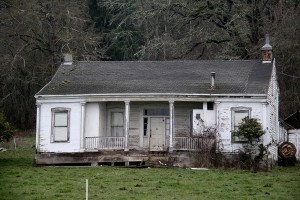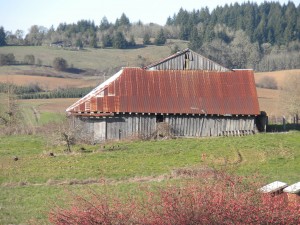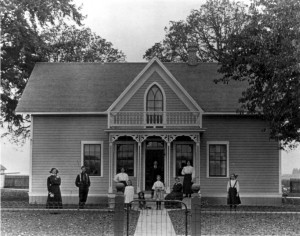Last year, Restore Oregon listed the categorical group of Willamette Valley Pioneer Houses and Farmsteads as one of Oregon’s Most Endangered Places. Often referred to as “Oregon’s oldest buildings,” these handmade buildings marked the end of the Oregon Trail from 1841 to 1865. While their significance to our state’s history is paramount, these buildings are being lost at an alarming rate. There were more than 4,600 houses and barns in the Willamette Valley in 1865, but just 5% are still standing. And of that remnant, most of them are today greatly threatened by deferred maintenance, economic challenges, land use barriers, and a general lack of public awareness of their importance.

listed on the National Register of Historic Places, it is
today vacant and in need of new use
(Photo courtesy State Historic Preservation Office)
What’s Been Done?
In recent months, Restore Oregon has collaborated with the State Historic Preservation Office to document and assess the remaining Pioneer era buildings. Laying the groundwork for future advocacy efforts, we’ve:
- Conducted a nine-county historic resource survey to identify the location, age, and condition of all remaining houses and barns built between 1841 and 1865.
- Authored a 65-page study on the historic significance of these properties and outlined advocacy opportunities.
- Completed a Multiple Property Documentation Form to streamline the listing of individual properties on the National Register.
- Presented to landmarks commissions and city councils up and down the valley.
What’s Still to Come?
Restore Oregon is leading a multi-pronged effort to build public awareness and develop models for how these buildings can be restored and made economically viable. In 2014 we will:

of just 23 pioneer barns still standing in the Willamette
Valley. Estimates show that in 1865 there were 4, 600
barns in the valley (Photo courtesy BA Beierle).
- Conduct intensive reuse studies for three pioneer-era properties to identify options for their rehabilitation and reuse. Properties identified for study include the Sam Brown House, Bybee Howell House, and Dibble House.
- Document and record the mere 23 pioneer-era barns still standing.
- Host a Tour, Talk & Picnic at Forest Grove’s 1848 Beeks House, which is currently undergoing sensitive rehabilitation for private use (tickets on sale next month).
- Organize six Preservation Pub presentations and discussions about pioneer houses and farmsteads. These one-hour programs will be held in communities across the Willamette Valley and are open to all:
- Albany. April 23.
- Corvallis. May 29.
- McMinnville. June 2.
- Eugene, Salem, Oregon City. September TBA.

period (Photo courtesy National Register Nomination)
We know there are no one-size-fits-all answers for saving these places, but Restore Oregon is looking forward to identifying the tools and solutions that will eventually rehabilitate and reactivate Oregon’s oldest buildings.


One Reply to “Saving the Remnants of Our Pioneer Places”
Comments are closed.